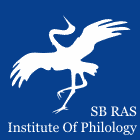 |
|
||||||||||||
|
Institute of Philology of
the Siberian Branch of Russian Academy of Sciences |
|
||||||||||||
|
|||||||||||||
DOI: 10.25205/2307-1737 Roskomnadzor certificate number Эл № ФС 77-84784 | |
| Kritika i Semiotika (Critique and Semiotics) | |
|
Article
Authors: Natalya A. Muratova, Galina A. Zhilicheva Novosibirsk State Pedagogical University, Novosibirsk, Russian Federation
Abstract: The article uses the material of M. A. Bulgakov’s novella “Morphine” and other works of the writer, including “Notes of a Young Doctor”, “The Doctor’s Extraordinary Adventures”, “The Dog’s Heart”, as well as the text of Sergei Bodrov Jr.’s script and A. O. Balabanov’s screenplay to show the ways of adapting specific features of Bulgakov’s cine poetics in filmic narratives. We have examined how the internal structure of the discourse of recordings in “Morphine” appeals to intentional elements of visualisation at the expense of demonstrative detachment, in some places almost nominative, certainly having in mind the formed culture of the reader-film-viewer; specific techniques of scripted and filmic representations of filmic metaphors in the writer’s prose are analysed. The relevance of the filmic context in the poetics of “Morphine” is also noted with references to well-known studies, however, it is emphasised that what in the movies of the German Expressionist demonstrated the dual nature of reality, the ambivalence of the subject of action, in Bulgakov’s narrative is realised in the signs of cinema itself, where the experimental synthetic nature of the image is fully manifested. S. Bodrov’s screenplay is considered as a phenomenon of the transition of literary discourse to cinematic, with an emphasis on musical counterpoint and “action-narrative”, while the discrepancies between the literary source, the script and the film are thought by the authors within the boundaries of the problem of intersemiotic translation. Keywords: cinematography of literature, cine optics of the narrator, M. Bulgakov, “Morphine”, script, S. Bodrov Jr., A. Balabanov Bibliography: Koltsova N. Z., Neklyudova O. A. K voprosu o kinematograficheskoi tekhnike v tvorchestve M. Bulgakova: ot “Diavoliady” k “Masteru i Margarite” [On the Cinematic Technique in Mikhail Bulgakov’s Works: from “The Diaboliad” to “The Master and Margarita”]. Vestnik Buryatskogo gosudarstvennogo uni-versiteta [Bulletin of Buryat State University], 2015, no. 10 (1), pp. 155–161. (in Russ.) Muratova N. A., Zhilicheva G. A. Diskursivnye praktiki kultury. Literatura i kino v aspektakh teoreticheskoi i istoricheskoi poetiki [Discursive Practices of Culture: Literature and Cinema in Terms of Theoretical and Historical Poetics]. Novosibirsk, NSPU Press, 2022, 187 p. (in Russ.) Neklyudova O. A. Kinoseans chernoi magii. K voprosu o kinematograficheskikh istochnikakh romana M. Bulgakova “Master i Margarita” [A Screen-ing of Black Magic: On the Cinematic Sources of Mikhail Bulgakov’s Novel “The Master and Margarita”]. Voprosy literatury [Questions of Literature], 2017, no. 2, pp. 229–245. (in Russ.) Petrovsky M. Master i Gorod (Kievskie konteksty Mikhaila Bulgakova) [The Master and the City (Mikhail Bulgakov’s Kiev Contexts]. St. Petersburg, Ivan Limbakh Publ., 2008, 464 p. (in Russ.) Salnikova E. V. Prostranstvo goroda i povestvovaniya v fil'me “Kabinet doktora Kaligari” [Urban and Narrative Space in the Film “The Cabinet of Dr. Caligari”]. Nauka televideniya [Science of Television], 2020, vol. 16.2, pp. 45–68. (in Russ.) Silina L. A. Osobennosti montazhnoi kompozitsii v romanax M. A. Bulgakova “Belaya gvardiya” i “Master i Margarita” [Features of montage composi-tion in M. A. Bulgakov’s novels “The White Guard” and “The Master and Mar-garita”]. Izvestiya VGPU. Rubrika: Voprosy izucheniya sovremennij literatury, 2012, no. 2 (66), pp. 137–140. (in Russ.) Tarasov A. V. Kinematograf M. A. Bulgakova. K probleme kinematografichnosti khudozhestvennogo myshleniya pisatelya [The Cinematic Imagina-tion of M. A. Bulgakov: On the Problem of Cinematic Thinking in His Artistic Work]. Cand. of Cultural Studies Diss. Shuya, 2006, 187 p. (in Russ.) Yablokov E. A. Tekst i podtekst v rasskazakh M. Bulgakova (“Zapiski yunogo vracha”) [Text and Subtext in Mikhail Bulgakov’s Stories (“A Young Doctor’s Notebook”)]. Tver, TSU Press, 2002, 103 p. (in Russ.) Yangirov R. M. Spetsifika kinematograficheskogo konteksta v russkoi liter-ature 1910-kh – 1920-kh godov [The Specifics of Cinematic Context in Rus-sian Literature of the 1910s–1920s]. Cand. of Philol. Sci. Diss. Moscow, 2000, 230 p. (in Russ.) Zhurkova D. A. Muzykal'naya dramaturgiya fil'ma “Morfii” Alekseya Balabanova [Musical Dramaturgy of the Film “Morphine” by Aleksei Balabanov]. Muzyka i ekrannye iskusstva kontsa XX – nachala XXI veka [Music and Screen Arts of the Late 20th – Early 21st Century], 2018, no. 4, pp. 252–269. (in Russ.) |
 |
Institute of Philology Nikolaeva st., 8, Novosibirsk, 630090, Russian Federation +7-383-330-15-18, ifl@philology.nsc.ru |
© Institute of Philology |


